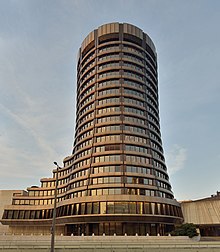
The Bank for International Settlements (BIS; French: Banque des règlements internationaux, BRI) is an international company limited by shares owned by central banks which "fosters international monetary and financial cooperation and serves as a bank for central banks".[2] The BIS carries out its work through subcommittees, the secretariats it hosts and through an annual general meeting of all member banks. It also provides banking services, but only to central banks and other international organizations. It is based in Basel, Switzerland, with representative offices in Hong Kong and Mexico City...
...The BIS was established on May 17, 1930, by an intergovernmental agreement by Germany, Belgium, France, the United Kingdom, Italy, Japan, the United States and Switzerland.[3][4]
The BIS was originally intended to facilitate reparations imposed on Germany by the Treaty of Versailles after World War I.[5] The need to establish a dedicated institution for this purpose was suggested in 1929 by the Young Committee, and was agreed to in August of that year at a conference at The Hague. A charter for the bank was drafted at the International Bankers Conference at Baden-Baden in November, and its charter was adopted at a second Hague Conference on January 20, 1930. According to the charter, shares in the bank could be held by individuals and non-governmental entities. The BIS was constituted as having corporate existence in Switzerland on the basis of an agreement with Switzerland acting as headquarters state for the bank. It also enjoyed immunity in all the contracting states.
The evidence had been mounting throughout the war that the BIS had helped the Germans loot assets from occupied countries, including gold rings and other items from labor and prison camp victims.[6] The most notorious incident was the Bank of England's transfer to the BIS gold looted by the Nazis after their invasion of Czechoslovakia in 1939.'[7] The fact that top level German industrialists and advisors sat on the BIS board is ample evidence to understand how the BIS was used by Hitler throughout the war, with the help of American, British and French banks. Between 1933 and 1945 the BIS board of directors included Walther Funk, a prominent Nazi official, and Emil Puhl, as well as Hermann Schmitz, the director of IG Farben and Baron von Schroeder, the owner of the J.H. Stein Bank....
Members
The number of countries represented in each continent are: 35 in Europe, 13 in Asia, 5 in South America, 3 in North America, 2 in Oceania, and 2 in Africa. Sixty member central banks or monetary authorities of these countries...
https://en.wikipedia.org/wiki/Bank_for_International_Settlements

No comments:
Post a Comment